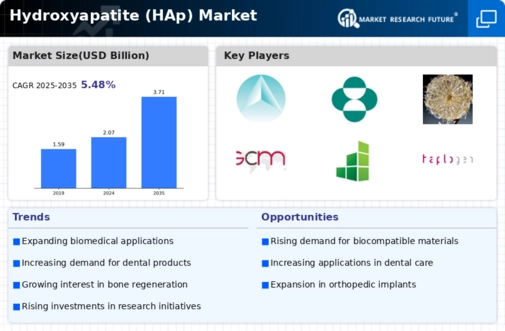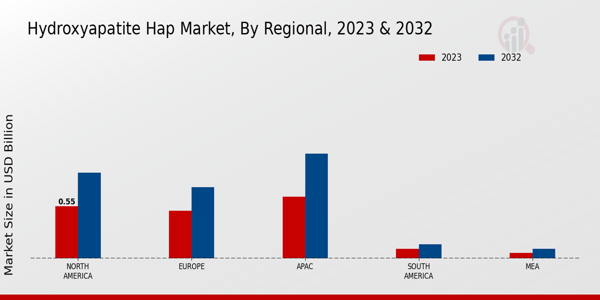Market Growth Projections
The Global Hydroxyapatite (HAp) Market Industry is projected to experience substantial growth over the coming years. The market is expected to reach a value of 2.07 USD Billion in 2024, with further growth anticipated to 3.71 USD Billion by 2035. This growth trajectory indicates a compound annual growth rate of 5.46% from 2025 to 2035. Such projections reflect the increasing demand for hydroxyapatite in various sectors, including biomedical applications and consumer health products. The market's expansion is likely to be driven by factors such as technological advancements, rising awareness of bone health, and regulatory support for biocompatible materials.
Rising Awareness of Bone Health
There is a growing awareness of bone health among consumers, which significantly influences the Global Hydroxyapatite (HAp) Market Industry. As individuals become more informed about the importance of maintaining healthy bones, the demand for supplements containing hydroxyapatite is likely to increase. This trend is particularly evident in regions with aging populations, where osteoporosis and related conditions are prevalent. The market's expansion is further supported by educational campaigns promoting the benefits of HAp in enhancing bone density and overall skeletal health. Consequently, this heightened awareness is expected to contribute to a compound annual growth rate of 5.46% from 2025 to 2035.
Expanding Applications in Orthopedics
The Global Hydroxyapatite (HAp) Market Industry is witnessing an expansion in applications within orthopedics, driven by the increasing incidence of bone-related disorders. Hydroxyapatite's properties make it suitable for use in coatings for orthopedic implants, enhancing their integration with bone tissue. As the global population ages and the prevalence of conditions such as arthritis rises, the demand for orthopedic surgeries is expected to grow. This trend is reflected in the projected market value of 3.71 USD Billion by 2035, indicating a robust future for HAp in orthopedic applications. The ongoing research into novel applications further supports this growth, suggesting a dynamic market landscape.
Growing Demand in Biomedical Applications
The Global Hydroxyapatite (HAp) Market Industry experiences a notable surge in demand due to its extensive applications in biomedical fields, particularly in bone grafting and dental implants. Hydroxyapatite's biocompatibility and osteoconductivity make it an ideal material for these applications. As the global population ages, the need for orthopedic and dental procedures increases, driving market growth. In 2024, the market is projected to reach 2.07 USD Billion, reflecting the rising adoption of HAp in medical devices and regenerative medicine. This trend suggests a robust future for the industry as advancements in technology further enhance HAp's efficacy in clinical settings.
Technological Advancements in Manufacturing
Technological advancements in the production of hydroxyapatite are poised to enhance the Global Hydroxyapatite (HAp) Market Industry significantly. Innovations in synthesis methods, such as improved precipitation techniques and biomimetic approaches, lead to higher purity and better performance of HAp products. These advancements not only improve the quality of HAp but also reduce production costs, making it more accessible for various applications. As manufacturers adopt these technologies, the market is likely to witness increased competition and a broader range of products. This evolution in manufacturing processes is expected to support the market's growth trajectory, particularly in the biomedical sector.
Regulatory Support for Biocompatible Materials
Regulatory bodies worldwide are increasingly supporting the use of biocompatible materials, which positively impacts the Global Hydroxyapatite (HAp) Market Industry. Guidelines and standards promoting the use of HAp in medical devices and implants facilitate its acceptance among manufacturers and healthcare providers. This regulatory environment encourages innovation and investment in HAp-related products, leading to enhanced market growth. As more products gain regulatory approval, the confidence in hydroxyapatite's safety and efficacy is likely to increase, further driving its adoption in various applications. This supportive framework is essential for the sustained growth of the HAp market.

















